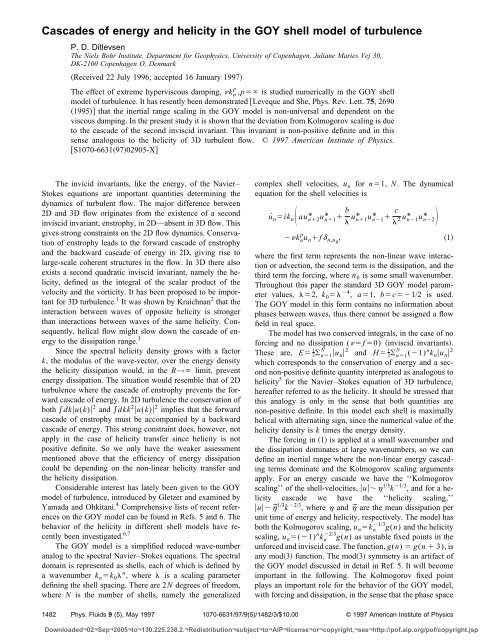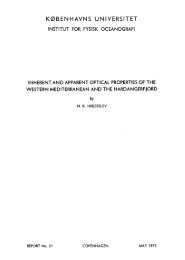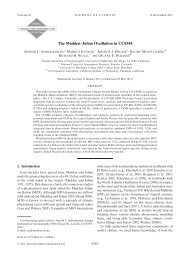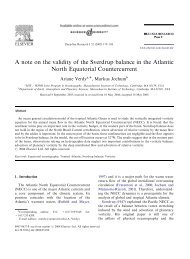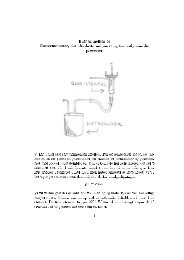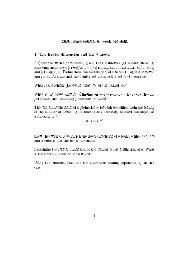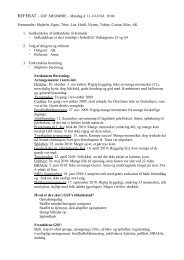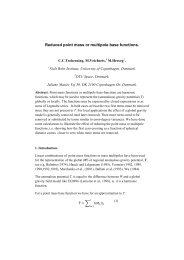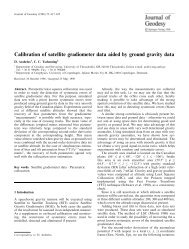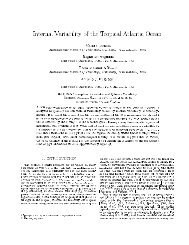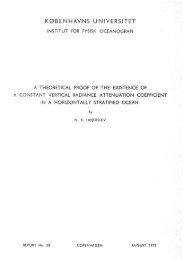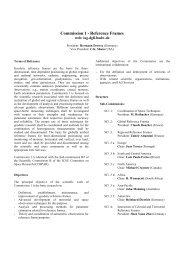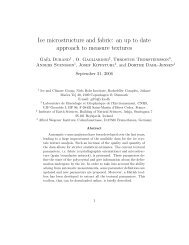Cascades of energy and helicity in the GOY shell model of turbulence
Cascades of energy and helicity in the GOY shell model of turbulence
Cascades of energy and helicity in the GOY shell model of turbulence
Create successful ePaper yourself
Turn your PDF publications into a flip-book with our unique Google optimized e-Paper software.
<strong>Cascades</strong> <strong>of</strong> <strong>energy</strong> <strong>and</strong> <strong>helicity</strong> <strong>in</strong> <strong>the</strong> <strong>GOY</strong> <strong>shell</strong> <strong>model</strong> <strong>of</strong> <strong>turbulence</strong>P. D. DitlevsenThe Niels Bohr Institute, Department for Geophysics, University <strong>of</strong> Copenhagen, Juliane Maries Vej 30,DK-2100 Copenhagen O, DenmarkReceived 22 July 1996; accepted 16 January 1997The effect <strong>of</strong> extreme hyperviscous damp<strong>in</strong>g, k p n ,p is studied numerically <strong>in</strong> <strong>the</strong> <strong>GOY</strong> <strong>shell</strong><strong>model</strong> <strong>of</strong> <strong>turbulence</strong>. It has resently been demonstrated Leveque <strong>and</strong> She, Phys. Rev. Lett. 75, 26901995 that <strong>the</strong> <strong>in</strong>ertial range scal<strong>in</strong>g <strong>in</strong> <strong>the</strong> <strong>GOY</strong> <strong>model</strong> is non-universal <strong>and</strong> dependent on <strong>the</strong>viscous damp<strong>in</strong>g. In <strong>the</strong> present study it is shown that <strong>the</strong> deviation from Kolmogorov scal<strong>in</strong>g is dueto <strong>the</strong> cascade <strong>of</strong> <strong>the</strong> second <strong>in</strong>viscid <strong>in</strong>variant. This <strong>in</strong>variant is non-positive def<strong>in</strong>ite <strong>and</strong> <strong>in</strong> thissense analogous to <strong>the</strong> <strong>helicity</strong> <strong>of</strong> 3D turbulent flow. © 1997 American Institute <strong>of</strong> Physics.S1070-66319702905-XThe <strong>in</strong>vicid <strong>in</strong>variants, like <strong>the</strong> <strong>energy</strong>, <strong>of</strong> <strong>the</strong> Navier–Stokes equations are important quantities determ<strong>in</strong><strong>in</strong>g <strong>the</strong>dynamics <strong>of</strong> turbulent flow. The major difference between2D <strong>and</strong> 3D flow orig<strong>in</strong>ates from <strong>the</strong> existence <strong>of</strong> a second<strong>in</strong>viscid <strong>in</strong>variant, enstrophy, <strong>in</strong> 2D—absent <strong>in</strong> 3D flow. Thisgives strong constra<strong>in</strong>ts on <strong>the</strong> 2D flow dynamics. Conservation<strong>of</strong> enstrophy leads to <strong>the</strong> forward cascade <strong>of</strong> enstrophy<strong>and</strong> <strong>the</strong> backward cascade <strong>of</strong> <strong>energy</strong> <strong>in</strong> 2D, giv<strong>in</strong>g rise tolarge-scale coherent structures <strong>in</strong> <strong>the</strong> flow. In 3D <strong>the</strong>re alsoexists a second quadratic <strong>in</strong>viscid <strong>in</strong>variant, namely <strong>the</strong> <strong>helicity</strong>,def<strong>in</strong>ed as <strong>the</strong> <strong>in</strong>tegral <strong>of</strong> <strong>the</strong> scalar product <strong>of</strong> <strong>the</strong>velocity <strong>and</strong> <strong>the</strong> vorticity. It has been proposed to be importantfor 3D <strong>turbulence</strong>. 1 It was shown by Kraichnan 2 that <strong>the</strong><strong>in</strong>teraction between waves <strong>of</strong> opposite <strong>helicity</strong> is strongerthan <strong>in</strong>teractions between waves <strong>of</strong> <strong>the</strong> same <strong>helicity</strong>. Consequently,helical flow might slow down <strong>the</strong> cascade <strong>of</strong> <strong>energy</strong>to <strong>the</strong> dissipation range. 3S<strong>in</strong>ce <strong>the</strong> spectral <strong>helicity</strong> density grows with a factork, <strong>the</strong> modulus <strong>of</strong> <strong>the</strong> wave-vector, over <strong>the</strong> <strong>energy</strong> density<strong>the</strong> <strong>helicity</strong> dissipation would, <strong>in</strong> <strong>the</strong> R→ limit, prevent<strong>energy</strong> dissipation. The situation would resemble that <strong>of</strong> 2D<strong>turbulence</strong> where <strong>the</strong> cascade <strong>of</strong> enstrophy prevents <strong>the</strong> forwardcascade <strong>of</strong> <strong>energy</strong>. In 2D <strong>turbulence</strong> <strong>the</strong> conservation <strong>of</strong>both dku(k) 2 <strong>and</strong> dkk 2 u(k) 2 implies that <strong>the</strong> forwardcascade <strong>of</strong> enstrophy must be accompanied by a backwardcascade <strong>of</strong> <strong>energy</strong>. This strong constra<strong>in</strong>t does, however, notapply <strong>in</strong> <strong>the</strong> case <strong>of</strong> <strong>helicity</strong> transfer s<strong>in</strong>ce <strong>helicity</strong> is notpositive def<strong>in</strong>ite. So we only have <strong>the</strong> weaker assessmentmentioned above that <strong>the</strong> efficiency <strong>of</strong> <strong>energy</strong> dissipationcould be depend<strong>in</strong>g on <strong>the</strong> non-l<strong>in</strong>ear <strong>helicity</strong> transfer <strong>and</strong><strong>the</strong> <strong>helicity</strong> dissipation.Considerable <strong>in</strong>terest has lately been given to <strong>the</strong> <strong>GOY</strong><strong>model</strong> <strong>of</strong> <strong>turbulence</strong>, <strong>in</strong>troduced by Gletzer <strong>and</strong> exam<strong>in</strong>ed byYamada <strong>and</strong> Ohkitani. 4 Comprehensive lists <strong>of</strong> recent referenceson <strong>the</strong> <strong>GOY</strong> <strong>model</strong> can be found <strong>in</strong> Refs. 5 <strong>and</strong> 6. Thebehavior <strong>of</strong> <strong>the</strong> <strong>helicity</strong> <strong>in</strong> different <strong>shell</strong> <strong>model</strong>s have recentlybeen <strong>in</strong>vestigated. 6,7The <strong>GOY</strong> <strong>model</strong> is a simplified reduced wave-numberanalog to <strong>the</strong> spectral Navier–Stokes equations. The spectraldoma<strong>in</strong> is represented as <strong>shell</strong>s, each <strong>of</strong> which is def<strong>in</strong>ed bya wavenumber k n k 0 n , where is a scal<strong>in</strong>g parameterdef<strong>in</strong><strong>in</strong>g <strong>the</strong> <strong>shell</strong> spac<strong>in</strong>g. There are 2N degrees <strong>of</strong> freedom,where N is <strong>the</strong> number <strong>of</strong> <strong>shell</strong>s, namely <strong>the</strong> generalizedcomplex <strong>shell</strong> velocities, u n for n1, N. The dynamicalequation for <strong>the</strong> <strong>shell</strong> velocities isu˙ nik nau n2* u n1* b u n1* u n1* c 2 u n1* u n2* k n p u n f n,n0 ,where <strong>the</strong> first term represents <strong>the</strong> non-l<strong>in</strong>ear wave <strong>in</strong>teractionor advection, <strong>the</strong> second term is <strong>the</strong> dissipation, <strong>and</strong> <strong>the</strong>third term <strong>the</strong> forc<strong>in</strong>g, where n 0 is some small wavenumber.Throughout this paper <strong>the</strong> st<strong>and</strong>ard 3D <strong>GOY</strong> <strong>model</strong> parametervalues, 2, k 0 4 , a1, bc1/2 is used.The <strong>GOY</strong> <strong>model</strong> <strong>in</strong> this form conta<strong>in</strong>s no <strong>in</strong>formation aboutphases between waves, thus <strong>the</strong>re cannot be assigned a flowfield <strong>in</strong> real space.The <strong>model</strong> has two conserved <strong>in</strong>tegrals, <strong>in</strong> <strong>the</strong> case <strong>of</strong> n<strong>of</strong>orc<strong>in</strong>g <strong>and</strong> no dissipation ( f 0) <strong>in</strong>viscid <strong>in</strong>variants.These are, E 2 1 Nn1 u n 2 <strong>and</strong> H 2 1 Nn1 (1) n k n u n 2which corresponds to <strong>the</strong> conservation <strong>of</strong> <strong>energy</strong> <strong>and</strong> a secondnon-positive def<strong>in</strong>ite quantity <strong>in</strong>terpreted as analogous to<strong>helicity</strong> 5 for <strong>the</strong> Navier–Stokes equation <strong>of</strong> 3D <strong>turbulence</strong>,hereafter referred to as <strong>the</strong> <strong>helicity</strong>. It should be stressed thatthis analogy is only <strong>in</strong> <strong>the</strong> sense that both quantities arenon-positive def<strong>in</strong>ite. In this <strong>model</strong> each <strong>shell</strong> is maximallyhelical with alternat<strong>in</strong>g sign, s<strong>in</strong>ce <strong>the</strong> numerical value <strong>of</strong> <strong>the</strong><strong>helicity</strong> density is k times <strong>the</strong> <strong>energy</strong> density.The forc<strong>in</strong>g <strong>in</strong> 1 is applied at a small wavenumber <strong>and</strong><strong>the</strong> dissipation dom<strong>in</strong>ates at large wavenumbers, so we c<strong>and</strong>ef<strong>in</strong>e an <strong>in</strong>ertial range where <strong>the</strong> non-l<strong>in</strong>ear <strong>energy</strong> cascad<strong>in</strong>gterms dom<strong>in</strong>ate <strong>and</strong> <strong>the</strong> Kolmogorov scal<strong>in</strong>g argumentsapply. For an <strong>energy</strong> cascade we have <strong>the</strong> ‘‘Kolmogorovscal<strong>in</strong>g’’ <strong>of</strong> <strong>the</strong> <strong>shell</strong>-velocities, u 1/3 k 1/3 , <strong>and</strong> for a <strong>helicity</strong>cascade we have <strong>the</strong> ‘‘<strong>helicity</strong> scal<strong>in</strong>g,’’u˜1/3 k 2/3 , where <strong>and</strong> ˜ are <strong>the</strong> mean dissipation perunit time <strong>of</strong> <strong>energy</strong> <strong>and</strong> <strong>helicity</strong>, respectively. The <strong>model</strong> hasboth <strong>the</strong> Kolmogorov scal<strong>in</strong>g, u n k 1/3 n g(n) <strong>and</strong> <strong>the</strong> <strong>helicity</strong>scal<strong>in</strong>g, u n (1) n k 2/3 n g(n) as unstable fixed po<strong>in</strong>ts <strong>in</strong> <strong>the</strong>unforced <strong>and</strong> <strong>in</strong>viscid case. The function, g(n) g(n 3),isany mod3 function. The mod3 symmetry is an artifact <strong>of</strong><strong>the</strong> <strong>GOY</strong> <strong>model</strong> discussed <strong>in</strong> detail <strong>in</strong> Ref. 5. It will becomeimportant <strong>in</strong> <strong>the</strong> follow<strong>in</strong>g. The Kolmogorov fixed po<strong>in</strong>tplays an important role for <strong>the</strong> behavior <strong>of</strong> <strong>the</strong> <strong>GOY</strong> <strong>model</strong>,with forc<strong>in</strong>g <strong>and</strong> dissipation, <strong>in</strong> <strong>the</strong> sense that <strong>the</strong> phase space11482 Phys. Fluids 9 (5), May 1997 1070-6631/97/9(5)/1482/3/$10.00 © 1997 American Institute <strong>of</strong> PhysicsDownloaded¬02¬Sep¬2005¬to¬130.225.238.2.¬Redistribution¬subject¬to¬AIP¬license¬or¬copyright,¬see¬http://p<strong>of</strong>.aip.org/p<strong>of</strong>/copyright.jsp
FIG. 1. The st<strong>and</strong>ard <strong>GOY</strong> <strong>model</strong> with f 0 (1i)10 3 ,n 0 4 <strong>and</strong>10 5 . The <strong>model</strong> has 20 <strong>shell</strong>s <strong>and</strong> is as before <strong>the</strong> run for 3000 timeunits after a 1000 time units sp<strong>in</strong>up start<strong>in</strong>g from <strong>the</strong> unstable Kolmogorovfixed po<strong>in</strong>t. log (u n ) is shown as a function <strong>of</strong> <strong>the</strong> <strong>shell</strong> numbernlog (k n ). The l<strong>in</strong>e <strong>in</strong>dicates <strong>the</strong> Kolmogorov scal<strong>in</strong>g with a spectral slope<strong>of</strong> 1/3.trajectory <strong>of</strong> <strong>the</strong> <strong>shell</strong> velocities seems to ‘‘curl around’’ thispo<strong>in</strong>t with <strong>the</strong> average values <strong>of</strong> <strong>the</strong> velocities close to <strong>the</strong>fixed po<strong>in</strong>t values. It was shown <strong>in</strong> a numerical study byLeveque <strong>and</strong> She 8 that <strong>the</strong> <strong>in</strong>ertial range scal<strong>in</strong>g <strong>in</strong> <strong>the</strong> <strong>GOY</strong><strong>model</strong> is not universal <strong>and</strong> is dependent on <strong>the</strong> form <strong>of</strong> <strong>the</strong>viscous damp<strong>in</strong>g. They attributed this non-universality to <strong>the</strong>reflection <strong>of</strong> <strong>energy</strong> flow from <strong>the</strong> viscous subrange back <strong>in</strong>to<strong>the</strong> <strong>in</strong>ertial range <strong>in</strong> <strong>the</strong> case <strong>of</strong> hyperviscosity (p2). Bystudy<strong>in</strong>g <strong>the</strong> extreme case p, I suggest a different explanationfor <strong>the</strong> non-universality <strong>of</strong> <strong>the</strong> <strong>in</strong>ertial range scal<strong>in</strong>g,namely that <strong>the</strong> cascade <strong>of</strong> <strong>helicity</strong> blocks <strong>the</strong> cascade <strong>of</strong><strong>energy</strong> <strong>and</strong> thus changes <strong>the</strong> scal<strong>in</strong>g. This effect is probablyspecific to <strong>the</strong> <strong>GOY</strong> <strong>model</strong>, <strong>and</strong> a consequence <strong>of</strong> <strong>the</strong> specificodd–even asymmetry <strong>of</strong> <strong>the</strong> <strong>helicity</strong> <strong>in</strong> <strong>the</strong> <strong>GOY</strong> <strong>model</strong>.The numerical study is performed on two versions <strong>of</strong> <strong>the</strong><strong>GOY</strong> <strong>model</strong>. First, <strong>the</strong> usual <strong>model</strong> with normal (p2) dissipation<strong>and</strong> second, with viscosity only applied on <strong>the</strong> outermost<strong>shell</strong>, correspond<strong>in</strong>g to p hyperviscosity. Theforc<strong>in</strong>g <strong>in</strong> 1 is <strong>in</strong> both cases taken to be f f 0 /u n0* wheref 0 is a constant. This gives a constant <strong>in</strong>put <strong>of</strong> <strong>energy</strong> <strong>and</strong><strong>helicity</strong> per unit time.Figure 1 shows <strong>the</strong> result <strong>of</strong> a numerical calculation forf 0 (1i)10 3 ,n 0 4 <strong>and</strong> 10 5 . The <strong>model</strong> has 20<strong>shell</strong>s <strong>and</strong> is run for 3000 time units after a 1000 time unitssp<strong>in</strong>up start<strong>in</strong>g from <strong>the</strong> unstable Kolmogorov fixed po<strong>in</strong>t.The first panel shows log (u n ) as a function <strong>of</strong> <strong>the</strong> <strong>shell</strong>number nlog (k n ), where • denotes <strong>the</strong> temporal average.The spectral slope is close to <strong>the</strong> Kolmogorov scal<strong>in</strong>g,shown by <strong>the</strong> l<strong>in</strong>e, thus <strong>the</strong> <strong>model</strong> shows an <strong>energy</strong> cascade.The sources <strong>and</strong> s<strong>in</strong>ks for <strong>energy</strong> <strong>and</strong> <strong>helicity</strong> areĖ u n*f n k 2 n u 2 n 2n<strong>and</strong>Ḣ 1 n k n u n*f n 1 n k 3 n u 2 n . 3nThis means that <strong>the</strong> <strong>helicity</strong> <strong>of</strong> opposite signs is dissipatedat every second <strong>shell</strong> <strong>and</strong> <strong>the</strong>refore total <strong>helicity</strong> isproduced for odd numbered <strong>shell</strong>s <strong>in</strong> <strong>the</strong> dissipation range.FIG. 2. The modified <strong>GOY</strong> <strong>model</strong> with f 0 (1i)10 8 <strong>and</strong> 0 10 7 k 2 20 429.5. This <strong>model</strong> has likewise 20 <strong>shell</strong>s <strong>and</strong> is run for3000 time units. The first panel is <strong>the</strong> same as <strong>in</strong> Fig. 1. The l<strong>in</strong>e <strong>in</strong> <strong>the</strong>figure has a slope <strong>of</strong> 2/3 correspond<strong>in</strong>g to <strong>the</strong> cascade <strong>of</strong> <strong>helicity</strong>. Secondpanel shows <strong>the</strong> spectrum <strong>of</strong> U n u(n1)u(n)u(n1) 1/3 . The l<strong>in</strong>e has aslope <strong>of</strong> 1/2 correspond<strong>in</strong>g to <strong>the</strong> equipartition <strong>of</strong> <strong>helicity</strong>.The <strong>in</strong>ertial range flow is dom<strong>in</strong>ated by <strong>the</strong> non-l<strong>in</strong>eartransfer <strong>of</strong> <strong>the</strong> conserved quantities. The key assumption byKolmogorov 1941 is that <strong>the</strong> <strong>in</strong>ertial range flow does notdepend on <strong>the</strong> specific form <strong>of</strong> <strong>the</strong> small scale viscous dissipation.This is not <strong>the</strong> case for <strong>the</strong> <strong>GOY</strong> <strong>model</strong>. In order toillustrate this po<strong>in</strong>t a study <strong>of</strong> a slightly modified <strong>GOY</strong><strong>model</strong> is presented here. The dissipation is taken to be activeonly on <strong>the</strong> outermost <strong>shell</strong>, number N20; this correspondsto hyperviscosity <strong>in</strong> <strong>the</strong> limit, p⇒, with 0 k pN <strong>and</strong> 0 held constant. With this choice <strong>of</strong> dissipation <strong>the</strong> behavior<strong>of</strong> <strong>the</strong> <strong>GOY</strong> <strong>model</strong> changes dramatically even though <strong>the</strong>non-l<strong>in</strong>ear terms <strong>in</strong> <strong>the</strong> govern<strong>in</strong>g equation rema<strong>in</strong>s unchanged.Figure 2 shows <strong>the</strong> result <strong>of</strong> a numerical <strong>in</strong>tegration with<strong>the</strong> modified <strong>GOY</strong> <strong>model</strong> where f 0 (1i)10 8 <strong>and</strong> 0 10 7 k 2 20 429.5. The first panel shows <strong>the</strong> velocityspectrum where <strong>the</strong> mod3 symmetry <strong>of</strong> <strong>the</strong> <strong>shell</strong> <strong>model</strong>becomes dom<strong>in</strong>ant. The scal<strong>in</strong>g behavior <strong>of</strong> <strong>shell</strong>s numbered10,13,16,19 is different from <strong>the</strong> rest. The l<strong>in</strong>e <strong>in</strong> <strong>the</strong> figurehas a slope <strong>of</strong> 2/3 correspond<strong>in</strong>g to <strong>the</strong> cascade <strong>of</strong> <strong>helicity</strong>ra<strong>the</strong>r than <strong>energy</strong>.However, if U n u(n1)u(n)u(n1) 1/3 is considered<strong>the</strong> mod3 symmetry is elim<strong>in</strong>ated <strong>and</strong> <strong>the</strong> <strong>in</strong>ertialrange scal<strong>in</strong>g approximately reemerges as an arithmeticmean <strong>of</strong> <strong>the</strong> scal<strong>in</strong>g behaviors for <strong>the</strong> <strong>shell</strong>s3n, 3n1, 3n2 Fig. 2, second panel. The l<strong>in</strong>e <strong>in</strong> <strong>the</strong>figure has a slope <strong>of</strong> 1/2 correspond<strong>in</strong>g to equipartition<strong>in</strong>g<strong>of</strong> <strong>helicity</strong>. The hyper-viscosity <strong>of</strong> <strong>the</strong> <strong>model</strong>, only pull<strong>in</strong>gout <strong>helicity</strong> through <strong>the</strong> 18, 19, 20 triad, cannot ma<strong>in</strong>ta<strong>in</strong> a<strong>helicity</strong> cascade.The result can be <strong>in</strong>terpreted as a spectral bump at <strong>the</strong>end <strong>of</strong> <strong>the</strong> spectrum with an approximate equipartition <strong>of</strong><strong>helicity</strong>. Similar results have been found by Borue <strong>and</strong>Phys. Fluids, Vol. 9, No. 5, May 1997Brief Communications1483Downloaded¬02¬Sep¬2005¬to¬130.225.238.2.¬Redistribution¬subject¬to¬AIP¬license¬or¬copyright,¬see¬http://p<strong>of</strong>.aip.org/p<strong>of</strong>/copyright.jsp
Orszag 9 for numerical simulations <strong>of</strong> <strong>the</strong> 3D Navier–Stokesequation. In this case <strong>the</strong> accumulation seems to be an effect<strong>of</strong> <strong>energy</strong> not be<strong>in</strong>g able to be transferred across <strong>the</strong> ultravioletcut<strong>of</strong>f.In <strong>the</strong> case ( f 0) <strong>the</strong> <strong>model</strong> has, discard<strong>in</strong>g <strong>the</strong>boundary effects, besides <strong>the</strong> two scal<strong>in</strong>g fixed po<strong>in</strong>ts a periodicsolution. It is easy to verify that <strong>the</strong> follow<strong>in</strong>g satisfies<strong>the</strong> dynamical equation 1:u 3n2 tsk 1 0 3n ,u 3n1 t 3n 1 e i 1 2 t ,u 3n t 3n 2 e i 1 2 t ,with 1 s 4 1b 2 c 31 ,45 2 s 33 1b 31 c 31 ,<strong>and</strong> s is an arbitrary constant. The scal<strong>in</strong>g parameter, , isrelated to <strong>the</strong> scal<strong>in</strong>g fixed po<strong>in</strong>t by (1)/3, wherez is a solution to 1bzcz 2 0, thus a generator <strong>of</strong>one <strong>of</strong> <strong>the</strong> conserved quantities. 10 So <strong>the</strong>re are two valuespossible for ; (2i/log())/3 correspond<strong>in</strong>g to <strong>the</strong>generator, z2, <strong>of</strong> <strong>helicity</strong>, or <strong>the</strong> fluxless fixed po<strong>in</strong>t <strong>of</strong><strong>the</strong> <strong>GOY</strong> <strong>model</strong>, <strong>and</strong> 1/3 correspond<strong>in</strong>g to <strong>the</strong> generator,z1, <strong>of</strong> <strong>energy</strong>, or <strong>the</strong> Kolmogorov fixed po<strong>in</strong>t.There is <strong>in</strong> this periodic solution a complete phase lock<strong>in</strong>g<strong>of</strong> all <strong>the</strong> <strong>shell</strong>s. The <strong>energy</strong> <strong>and</strong> <strong>helicity</strong> fluxes are bothzero <strong>in</strong> <strong>the</strong> periodic solution, so <strong>in</strong> some sense it correspondsto <strong>the</strong> fluxless fixed po<strong>in</strong>t <strong>of</strong> <strong>the</strong> <strong>GOY</strong> <strong>model</strong>.The <strong>shell</strong>-velocities <strong>of</strong> <strong>shell</strong>s 8, 11, 14, 17, 20 are out <strong>of</strong>phase with those <strong>of</strong> <strong>shell</strong>s 9, 12, 15, 18, while <strong>shell</strong>-velocities<strong>of</strong> <strong>shell</strong>s 10, 13, 16, 19 are almost constant. From this itseems as if <strong>the</strong> periodic solution plays <strong>the</strong> same role for thismodified <strong>GOY</strong> <strong>model</strong> as does <strong>the</strong> Kolmogorov fixed po<strong>in</strong>tfor <strong>the</strong> <strong>GOY</strong> <strong>model</strong>. This could <strong>in</strong>dicate <strong>the</strong> existence <strong>of</strong> anunstable limit cycle <strong>in</strong> <strong>the</strong> modified <strong>GOY</strong> <strong>model</strong>.The dissipation <strong>of</strong> <strong>helicity</strong> is irregular, associated with<strong>the</strong> bursts <strong>in</strong> <strong>shell</strong> number 20 <strong>and</strong> all o<strong>the</strong>r <strong>shell</strong>s, <strong>the</strong> <strong>energy</strong>dissipation is completely blocked, result<strong>in</strong>g <strong>in</strong> a steady<strong>in</strong>crease <strong>of</strong> <strong>energy</strong> concentrated on <strong>shell</strong>s 10,13,16,19. Themechanism for prevent<strong>in</strong>g <strong>the</strong> forward cascade <strong>of</strong> <strong>energy</strong> <strong>in</strong>this <strong>model</strong> is analogous to <strong>the</strong> 2D case, where <strong>the</strong> forwardcascade <strong>of</strong> enstrophy governs <strong>the</strong> dynamics.The system shows no signs <strong>of</strong> approach<strong>in</strong>g a statisticalequilibrium simply because <strong>the</strong> <strong>helicity</strong> can grow to arbitrarilylarge negative values dom<strong>in</strong>ated by <strong>shell</strong> number 19.The reason for this can be understood by exam<strong>in</strong><strong>in</strong>g <strong>the</strong> dissipative<strong>energy</strong> balance. In <strong>the</strong> case <strong>of</strong> normal viscosity itfollows from 2 that <strong>the</strong> phase space trajectory will be attractedto <strong>the</strong> hyper-ellipsoid given by k 2 n u n 2 f whichis a compact 2N1 dimensional object. In <strong>the</strong> p casethis object will be <strong>the</strong> 2N1 dimensional ‘‘hyper-cyl<strong>in</strong>der’’def<strong>in</strong>ed by u 20 f /k 2 20 ). This is not compact <strong>and</strong> ergodicitydoes not apply, thus <strong>the</strong> p→ is a s<strong>in</strong>gular limit <strong>and</strong> nostatistical equilibrium can be reached. The relative change <strong>in</strong><strong>energy</strong> over <strong>the</strong> <strong>in</strong>tegration is <strong>of</strong> <strong>the</strong> order 10 2 such that <strong>the</strong>system is <strong>in</strong> a quasi-equilibrium state where statistical equilibriumis reestablished <strong>in</strong> <strong>the</strong> limit where <strong>the</strong> <strong>energy</strong> <strong>in</strong>jectionrate goes to zero. Tak<strong>in</strong>g an even smaller forc<strong>in</strong>g doesnot change <strong>the</strong> statistics, thus <strong>the</strong> statistical time averag<strong>in</strong>g ismean<strong>in</strong>gful.If <strong>the</strong> <strong>energy</strong> cascade is effectively blocked <strong>the</strong> <strong>energy</strong>should be pulled out <strong>of</strong> <strong>the</strong> system by a drag at <strong>the</strong> smallwavenumbers correspond<strong>in</strong>g to <strong>the</strong> backward cascade <strong>in</strong> 2D.This is not seen, so an <strong>in</strong>verse <strong>energy</strong> cascade cannot beestablished. The <strong>model</strong> was also run with <strong>the</strong> usual dissipationbut only active on every second <strong>shell</strong>. The result <strong>of</strong> thisrun was essentially <strong>the</strong> same as for <strong>the</strong> modified <strong>GOY</strong> <strong>model</strong>.In conclusion we see that <strong>the</strong> non-l<strong>in</strong>ear transfer <strong>in</strong> <strong>the</strong><strong>GOY</strong> <strong>model</strong> depends crucially on <strong>the</strong> dissipation propertiesfor both conserved quantities, <strong>energy</strong> <strong>and</strong> <strong>helicity</strong>. It is stillan open question how much <strong>the</strong> <strong>GOY</strong> <strong>model</strong> reflects <strong>the</strong>dynamics <strong>of</strong> <strong>the</strong> Navier–Stokes equation. These f<strong>in</strong>d<strong>in</strong>gs certa<strong>in</strong>ly<strong>in</strong>dicate that <strong>the</strong> <strong>model</strong> is too restricted <strong>in</strong> some senseto represent real flow. The dissipative term <strong>in</strong>troduced <strong>in</strong> <strong>the</strong>modified <strong>model</strong> is certa<strong>in</strong>ly not very realistic, <strong>in</strong> real flow<strong>helicity</strong> <strong>of</strong> both signs will be dissipated, which it is not <strong>in</strong> <strong>the</strong>modified <strong>model</strong> presented here. The f<strong>in</strong>d<strong>in</strong>gs from thissimple <strong>model</strong> might <strong>in</strong>dicate that <strong>in</strong> <strong>the</strong> <strong>in</strong>ertial range flow<strong>the</strong> conservation <strong>of</strong> <strong>helicity</strong> could block <strong>the</strong> <strong>energy</strong> cascade<strong>and</strong> thus alter <strong>the</strong> Kolmogorov k 5/3 scal<strong>in</strong>g.ACKNOWLEDGMENTSI would like to thank A. Wi<strong>in</strong>-Nielsen, J. R. Herr<strong>in</strong>g, <strong>and</strong>R. M. Kerr for valuable discussions. The work was grantedby <strong>the</strong> Carlsberg foundation.1 J. C. Andre <strong>and</strong> M. Lesieur, ‘‘Influence <strong>of</strong> <strong>helicity</strong> on <strong>the</strong> evolution <strong>of</strong>isotropic <strong>turbulence</strong> at high Reynolds number,’’ J. Fluid Mech. 81, 1871977.2 R. H. Kraichnan, ‘‘Helical <strong>turbulence</strong> <strong>and</strong> absolute equilibrium,’’ J. FluidMech. 59, 745 1973.3 W-S. Wu, D. K. Lilly, <strong>and</strong> R. M. Kerr, ‘‘Helicity <strong>and</strong> <strong>the</strong>rmal convectionwith shear,’’ J. Atmos. Sci. 49, 1800 1991.4 M. Yamada <strong>and</strong> K. Ohkitani, ‘‘Lyapunov spectrum <strong>of</strong> a chaotic <strong>model</strong> <strong>of</strong>three-dimensional <strong>turbulence</strong>,’’ J. Phys. Soc. Jpn. 56, 4210 1987; ‘‘The<strong>in</strong>ertial subrange <strong>and</strong> non-positive Lyapunov exponents <strong>in</strong> fully-developed<strong>turbulence</strong>,’’ Progr. Theor. Phys. 79, 1265 1988; 60, 983 1988.5 L. Kadan<strong>of</strong>f, D. Lohse, J. Wang, <strong>and</strong> R. Benzi, ‘‘Scal<strong>in</strong>g <strong>and</strong> dissipation <strong>in</strong><strong>the</strong> <strong>GOY</strong> <strong>shell</strong> <strong>model</strong>,’’ Phys. Fluids 7, 617 1995.6 R. Benzi, L. Biferale, R. M. Kerr, <strong>and</strong> E. Trovatore, ‘‘Helical <strong>shell</strong> <strong>model</strong>sfor three dimensional <strong>turbulence</strong>,’’ Phys. Rev. E 53, 3541 1996.7 L. Biferale <strong>and</strong> R. Kerr, ‘‘On <strong>the</strong> role <strong>of</strong> <strong>in</strong>viscid <strong>in</strong>variants <strong>in</strong> <strong>shell</strong> <strong>model</strong>s<strong>of</strong> <strong>turbulence</strong>,’’ Phys. Rev. E 52, 6113 1995.8 E. Leveque <strong>and</strong> Z-S. She, ‘‘Viscous effects on <strong>in</strong>ertial range scal<strong>in</strong>g <strong>in</strong> adynamical <strong>model</strong> <strong>of</strong> <strong>turbulence</strong>,’’ Phys. Rev. Lett. 75, 2690 1995.9 V. Borue <strong>and</strong> S. A. Orszag, ‘‘Self-similar decay <strong>of</strong> three-dimensional homogeneous<strong>turbulence</strong> with hyperviscosity,’’ Phys. Rev. E 51, R8561995.10 P. D. Ditlevsen <strong>and</strong> I. A. Mogensen, ‘‘Cascade <strong>and</strong> statistical equilibrium<strong>in</strong> <strong>shell</strong> <strong>model</strong>s <strong>of</strong> <strong>turbulence</strong>,’’ Phys. Rev. E. 53, 4785 1996.1484 Phys. Fluids, Vol. 9, No. 5, May 1997 Brief CommunicationsDownloaded¬02¬Sep¬2005¬to¬130.225.238.2.¬Redistribution¬subject¬to¬AIP¬license¬or¬copyright,¬see¬http://p<strong>of</strong>.aip.org/p<strong>of</strong>/copyright.jsp


